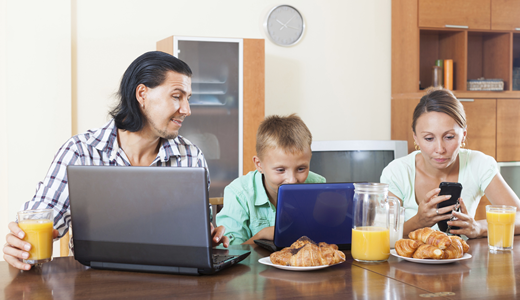How do we set and keep reasonable and appropriate screen-time limits for our children? With the proliferation of screens everywhere—largely due to the explosion of smartphone and tablet usage in the last few years—this is a pressing question for many parents.
But what if the answer begins not with our kids, but with us, not with their addictive tendencies but with our own?
That’s the main thrust of New York Times writer Jane E. Brody’s recent article “How to Cut Children’s Screen Time? Say No to Yourself First.” Brody interviews several psychologists who suggest that setting limits on our kids’ screen usage gets easier when we establish healthy boundaries for ourselves.
One of those experts is Harvard-affiliated psychologist Catherine Steiner-Adair, author of The Big Disconnect: Protecting Childhood and Family Relationships in the Digital Age. She says that children naturally imitate the behaviors of the adults in their lives. If we’re using our smartphones all the time, it’s no surprise that our kids are going to think that’s normal and healthy behavior. That strikes me as a common sense observation, but one that those of us with our own tech compulsions might reflexively want to dodge, sort of a 21st-century iteration of, “Do as I say, not as I do.”
Steiner-Adair also says it’s important for parents to establish screen-free zones to connect with kids “at critical times of the day, like when taking children to and from school. This should be a cell-free zone for everyone—no Bluetooth for parents or devices for the kids. The pickup from school is a very important transitional time for kids, a time for them to download their day. Parents shouldn’t be saying, ‘Wait a minute, I have to finish this call.'”
For parents who aren’t picking kids up from school, Steiner-Adair suggests a screen-free hour when everyone gets home at the end of the day. “[Parents] should walk in the door unplugged and use the first hour they’re home as time to reconnect with the family,” she says. And she identifies mealtimes—whether at home or in a restaurant—as a context where relationships, not screens, need to be the priority: “The art of dining and the connection between delicious food and nourishing conversation is being lost, not just in restaurants but at home as well.”
Echoing these suggestions is family therapist Susan Stiffelman, author of the book Parenting With Presence. She told The New York Times, “Make time for real-life activities with your kids that let them know that they’re worth your time and undivided attention. Do things together that nourish your relationship.” In a separate article for The Huffington Post, she also reiterated the importance of modeling healthy habits. “If you interrupt conversations when you get a text message or spend hours every night in front of your laptop, your kids will have a hard time accepting your admonition to unplug. Read a book, take a walk, paint, sing or take up piano. By showing your children that there really are ways to have fun that don’t require a plug or a battery, they’ll be more inclined to follow suit.”
Stiffelman acknowledges that making adjustments to family screen-time habits—both for our kids and for ourselves—likely won’t happen without some pain and pushback. “But,” she says, “being a parent requires that we make decisions based on what is in the best interest of our child, even if that decision triggers anger and upset.”
Stiffelman concludes, “Parents today are dealing with a challenge that no other generation has faced. None of us were prepared to deal with the intense pull and highly addictive nature of what the online world has to offer. We’re all learning on the fly, trying to make sense of devices and online destinations that, in many cases, our children understand better than we do. As parents, we have an opportunity to guide our kids so that they can learn habits that help them make use of the digital world, without being swallowed whole by it.”
I think Stiffelman’s right. We are all learning to navigate an online reality that has few inherent borders or boundaries other than the ones we establish for ourselves and for our families. And if we hope to keep our kids from being “swallowed whole” by that omnipresent digital world, we’ve first got to keep ourselves from being digitally ingested, too.






Recent Comments